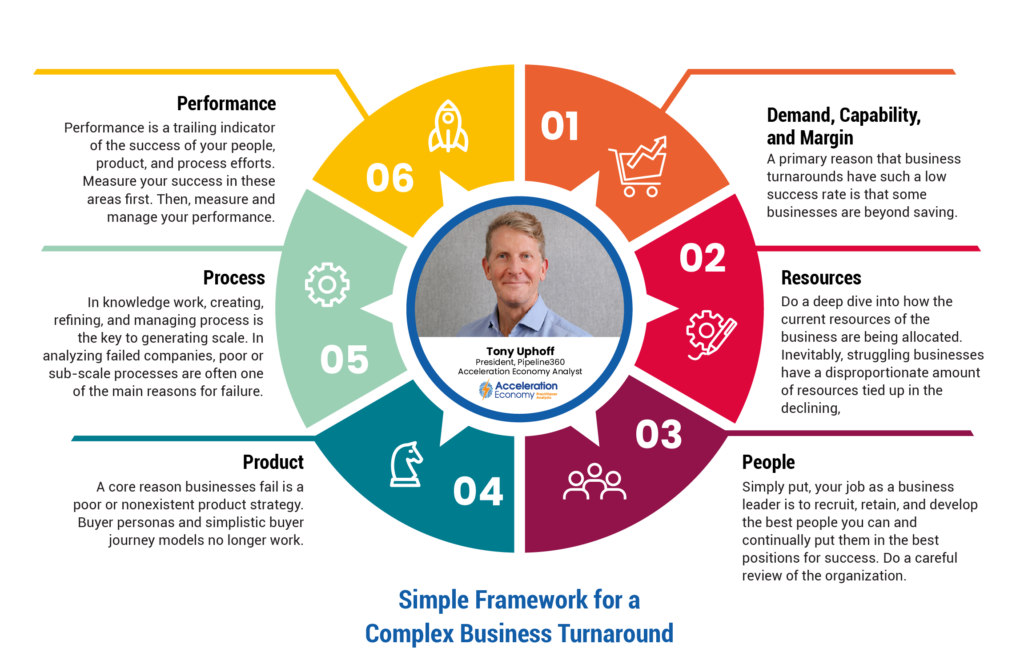Regardless of the age or size of your company, your model, or the market you serve, at some point, you will be faced with the need to execute a turnaround. While the need for business turnarounds is common, they are remarkably challenging to do successfully. Boston Consulting Group research shows that only 20% of business turnarounds are successful today, down from 30% in the year 2000.
Having helped lead the transformation and successful turnarounds of several businesses, I can personally attest that turning around a declining business is incredibly difficult. Reducing it to a simple checklist runs the risk of over-simplifying a complex, challenging endeavor. At the same time, there are frameworks to help you focus on the main drivers of a successful turnaround. One last upfront point: Turning around a declining company is not for the faint of heart. It takes remarkable energy, fortitude, and emotional resilience. Ok…now on to the framework
1) Demand, Capability, and Margin
A primary reason that business turnarounds have such a low success rate is that some businesses are beyond saving. I always start with three core questions:
- Is there a clear demand for the product or service the company offers?
- Does the company have sustainable differentiation?
- Can the company do so at a reasonable margin?
In my experience, you have to be able to answer yes to two out of three of these questions or a turnaround simply isn’t possible. It’s also my experience that if the answer to the first question is no, then there really isn’t a business to turn around.
2) Resources
Do a deep dive into how the current resources of the business are being allocated. Inevitably, struggling businesses have a disproportionate amount of resources tied up in the declining, unprofitable parts of the business, which starves potential growth areas. Certainly, understanding access to capital is a critical assessment to be made in a business turnaround. Access to capital can be a detriment in a turnaround, however, allowing managers to ignore the underlying problems.
Most successful business turnarounds involve the reallocation of resources, not the addition of new ones. Start by determining where you can shift resources and redeploy them for a better return as opposed to trying to add resources to an existing business that is failing.
3) People
Simply put, your job as a business leader is to recruit, retain, and develop the best people you can and continually put them in the best positions for success. Do a careful review of the organization.
Does the business have the right people, in the right positions, with the proper systems to enable them to be successful? Where are the talent gaps? Is the business organized properly? In many struggling businesses, organizational planning has been forgotten, resulting in a dysfunctional structure that is sub-optimal.
4) Product
A core reason businesses fail is a poor or nonexistent product strategy. Buyer personas and simplistic buyer journey models no longer work. Today, a more rigorous understanding of your buyers’ “jobs-to-be-done” is required. This process, pioneered by Harvard Professor and author Clayton Christensen, is now being used extensively in product design and development. By starting with your customers’ jobs-to-be-done, you will develop a deeper understanding of the problems they’re trying to solve that will serve as a guide for delivering a product that meets their needs.

5) Process
In knowledge work, creating, refining, and managing process is the key to generating scale. In analyzing failed companies, poor or sub-scale processes are often one of the main reasons for failure. The process can be tricky to isolate and analyze, too.
Process management needs to be a core competency in any successful turnaround. The best way to analyze process improvement is to look at your customer’s experience from interest-to-invoice. As you do so, you will find bottlenecks, duplicative processes, inefficiencies, and processes that can be eliminated, automated, or improved. Companies that have been in a sustained state of decline become slaves to a series of internal processes that have become irrelevant to customer value.
Let me restate this to be clear: Any internal process that doesn’t ultimately benefit customers should be re-examined and cut out if possible. You will find that in turnaround situations, it is in the process details where culture may rear its head. You may hear: “This is the way we’ve always done it” or “Our customers expect us to do it this way.” One of my personal favorites is: “We tried doing it differently but it didn’t work.”
In my experience, one of the quickest paths to business performance improvement is through process improvement.
6) Performance
Performance is a trailing indicator of the success of your people, product, and process efforts. Measure your success in these areas first. Then, measure and manage your performance.
One of the biggest challenges in declining businesses is that management gets caught up in the painfully obvious. The business is declining as opposed to focusing on the leading indicators that will help answer the question of why and what can be done about it. Set clear, measurable, and achievable performance metrics.
Many business turnarounds fail before they start based on management setting unrealistic performance metrics that the team doesn’t buy into. My recommendation is to organize your turnaround performance metrics around three key measurements:
- Performance against budget
- Performance against the previous year
- Performance against a goal, if relevant
Beware of getting caught up in vanity metrics. In struggling companies, in an effort to find something to celebrate, managers can get caught up in tracking metrics that really don’t matter. Focus myopically and only on metrics that matter, set them realistically, communicate them openly, and celebrate success milestones along the way.
Final Thoughts
Over the course of my career, I’ve been fortunate to have been involved in four successful turnarounds and learned some valuable lessons along the way. Most of them, I learned the hard way! Helping to lead a successful turnaround is an invaluable career experience and one that every C-level executive has had or will have to go through.
This article has been updated since it was originally published on September 19, 2022.










